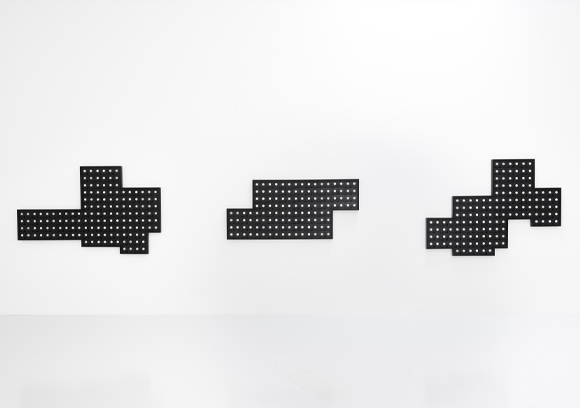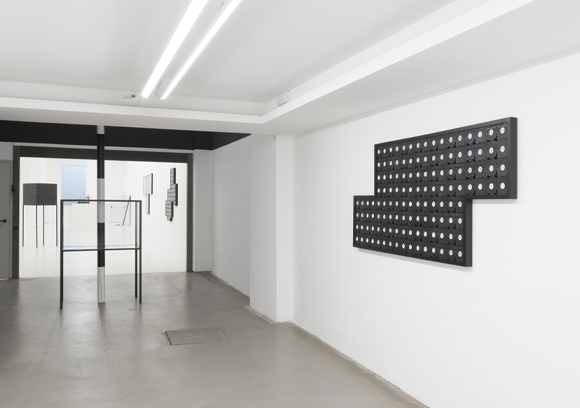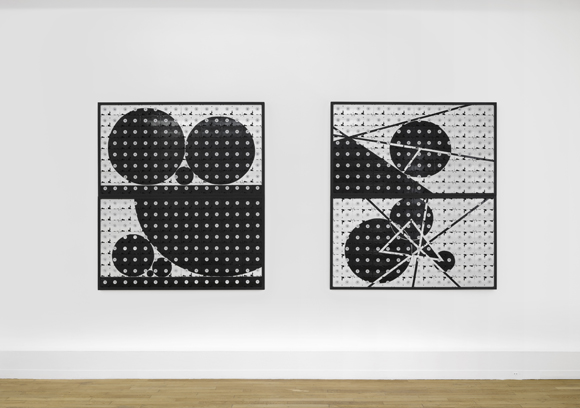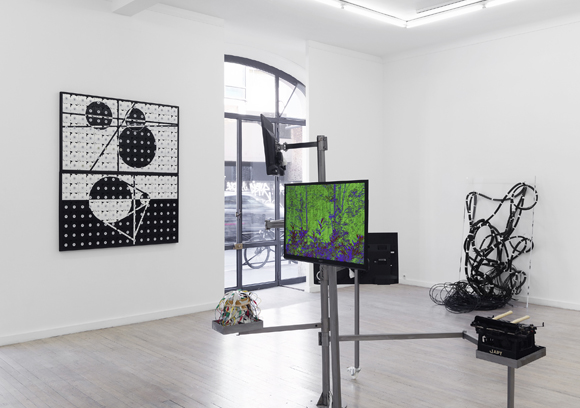| |
|
09. Propagande 02
 | Propaganda 02
| Propaganda 02 |
| |

'' This series of paintings explores the relations between communication and propaganda and observes how mass communication elaborated its techniques since the popularization of video recording and the fact it was able to enter millions
of households and reach the consciences of a great number of viewers. It observes the forms of social organizations that resulted from that, and their relation to individuals or their effect on them. ''
Studio Fatmi, January 2018

Propaganda
Exhibition view from How Much is Enough, Ceysson & Bénétière, 2022, Saint-Etienne.
Courtesy of the artist and Ceysson & Bénétière, Paris.

Propaganda
Exhibition view from The Observer Effect, ADN Galleria, 2021, Barcelona.
Courtesy of the artist and Ceysson & Bénétière, Paris.

Propaganda
Exhibition view from Printemps Paris,Ceysson & Bénétière, 2020, Paris.
Courtesy of the artist and Ceysson & Bénétière, Paris.

Propaganda
Exhibition view from The White Matter, Ceysson & Bénétière, 2019, Paris.
Courtesy of the artist and Ceysson & Bénétière, Paris.
|
|
2012, diptych, glycero on VHS, 150cm x 83,5cm each.
Courtesy of the artist and Ceysson & Bénétière, Paris.
|
|
|
|
« Propagande » est une série de peintures en noir et blanc commencées en 2012, dont les supports se composent d'alignements de cassettes VHS. Support d'enregistrement des images qui fut la norme dans les années 80 et 90 et devint un format grand public et commercial, la cassette VHS est également un matériau récurrent des œuvres de mounir fatmi, peintures, sculptures et installations.
Chacune de ces œuvres questionne la place de la communication et de la médiatisation dans nos sociétés contemporaines et tente de définir le rapport de l'art contemporain aux images et à leur pouvoir, en s'inspirant notamment de notions philosophiques développées par Guy Debord et de courants artistiques, tels que le minimalisme et le pop art, qui ont placé l'image ou sa disparition au centre de leurs préoccupations. La série de peintures explore plus particulièrement les liens entre communication et propagande, et observe de quelle manière la communication de masse a élaboré ses techniques depuis la popularisation de l'enregistrement vidéo et la possibilité pour celle-ci de faire son entrée dans des millions de foyers et d'atteindre les consciences de très nombreux spectateurs. Elle observe les formes d'organisations sociales qui en découlent, leurs rapports aux individus ou leurs effets sur eux.
Les compositions de « Propagande » multiplient les cercles et les courbes, figures très présentes dans le vocabulaire plastique que mounir fatmi emploie pour étudier les systèmes de production de significations, tels que le langage, la religion ou les sociétés. Dès le départ, la communication de masse conçoit ses principaux procédés, dont la simplicité n'a d'égale que l'efficacité, et dont le film de propagande, genre qui se propage à la même époque, se sert également : répétition, multiplication et accumulation des images, simplicité du message transmis, diffusion - autant de moyens qui tendent à égarer le spectateur et à induire un effet d'hypnose.
L'œuvre n'entend pas cependant que celui-ci se soumette au pouvoir des images. Si elle en utilise la rhétorique, elle en expose également les rouages afin de diminuer leur emprise. Les peintures de la série « Propagande » mettent à distance l'émotion générée par le spectacle habituel des images et optent pour la rigueur formelle de compositions géométriques où se révèlent fonctionnements, structures et rapports.
Studio Fatmi, Janvier 2018.
|
|
« Propaganda » is a series of black & white paintings initiated in 2012, the medium on which they are painted being rows of VHS tapes. A means for recording images that was the norm in the 1980s and 1990s and a widely used commercial format, the VHS tape is also a recurrent material in mounir fatmi’s work, used in paintings, sculptures or installations.
All of these pieces question the place of communication and media exposure in our contemporary societies and try to define the relation contemporary art has to images and their power – taking inspiration, among other things, from the philosophical notions developed by Guy Debord and from artistic movements such as minimalism and pop art that placed the image or its disappearance at the heart of their preoccupations. In particular, this series of paintings explores the relations between communication and propaganda and observes how mass communication elaborated its techniques since the popularization of video recording and the fact it was able to enter millions of households and reach the consciences of a great number of viewers. It observes the forms of social organizations that resulted from that, and their relation to individuals or their effect on them. ?
The « Propaganda » compositions make great use of circles and curves, figures that are frequently present in the plastic vocabulary mounir fatmi uses to study systems that produce significations, such as language, religion or societies. From its inception, mass communication conceived its own processes, whose simplicity only adds to their efficiency; processes that propaganda films, a genre that spread during that same period, use as well: the repetition, multiplication and accumulation of images, the simplicity of the message conveyed and widespread distribution – all these tend to confuse the viewer and create a hypnotic effect.
But here, the work doesn’t imply that the viewer should submit to the power of images. It uses that same rhetoric, but also exposes its inner functioning in order to reduce their grip. The paintings in the « Propaganda » series keep at a distance the emotion generated by the habitual spectacle of images and opt instead for the formal precision of geometric compositions where inner workings, structures and relations are revealed. ??
Studio Fatmi, January 2018. |
|
|
|